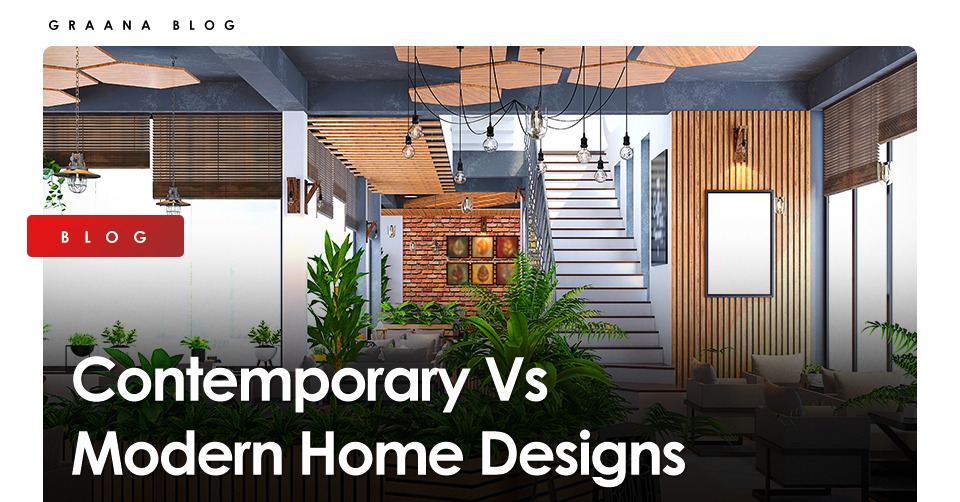The difference between a contemporary designed house and a contemporary designed house depends on the taste of people. Traditional houses are inspired by Victorian, Spanish, Neoclassical, Colonial styles, whereas contemporary styled houses are fashioned from the modern 20th century. Prominent elements of modern design include sleek lines, rectangular or square shapes, glass or transparent panels, and minimalism.
There is no doubt that taste matters while designing a house but what matters the most is sustainability. While traditional houses possess energy-efficient features, many contemporary homes are constructed by keeping conservation their main design. Today’s architecture is highly influenced by the green design movement and aims to establish eco-friendly elements with aesthetic styling and interior.
Today’s architecture is heavily influenced by the green design movement and seeks to integrate eco-friendly elements with stylistic aspects.
Traditionally designed residences are not much environmentally favourable because their design clashes with energy-efficient features. Since many people have a classic taste in style, it is not typical to see them opt for more furnishing or smart devices. For example, stainless-steel appliances in the kitchen with warm tones of colour or solar panels on a roof would not appeal to the eye. This leads to people investing in equipment based on style and now on sustainability. Thus, a conventional or a classic house may have room for recycled elements. Residents can invest in refurbished fixtures that are antique to decorate their traditional home.
In contemporary-based houses, sustainable materials are incorporated to make the house look fashionable yet sustainable. It ties the overall look of the home. However, the contemporary building has its stylistic limitations. For instance, if a greenhouse is made of recycled glass or concrete, or steel, its industrial frame and grey tones will not sync with all types of furnishing. A modern residence has sleek and minimalistic furniture to match the exterior beautifully. Get to know house designs in Pakistan.
Contemporary Home Design :
Be it your bedroom or kitchen; contemporary architecture is the more trending form of art right now.
Many modern designs were ideated from the ’70s that look futuristic enough to show some similarities to contemporary designs.
Today, contemporary design is a mixture of both; traditional and modern. It mainly focuses on edginess and practicality.
Surfaces such as steel and glass are mixed reused in this design. Round shapes that are bulkier are the most commonly used in contemporary designs.
When talking about lighting, it incorporates lighting effects such as lights coming from under the bed, unlike traditional or modern lamplights. Contemporary homerooms are more solid, having a little whitewash that leaves empty spaces, for instance, wide windows or glass panels.
Natural materials such as wood, ceramics are blended and mixed with industrial ones such as plastic and metal. What matters the most here is practicality rather than exteriority.
The modern design reflects a specific era of the mid-20th century. However, it also refers to the first age of total mass production of furniture pieces and planning from the 1920s to the 1950s. Modern design usually refers to a specific era of the mid-twentieth century.
Colours under this category are bright, and the lighting is preferred to be natural and standing ones such as a tall lamplight or a large window.
Modern vs Contemporary Design Colors :
Modern colours project the time or the era that the design is inspired from. Modern designs were about being different and unique. You would have observed the use of wood with bold earthy tones to give a stand-out look.
When looking at typical modern designs, you will often notice a contrast of earthy tones mixed with autumnal shades such as ochre, brown, red with a touch of gold to accent. Being used as a part of modern designs, even these bright colours complement the other shades in contrast.
As discussed above, contemporary designs reflect shin and smooth surfaces. It requires lines, a minimalistic approach to colours, and refined architecture. It is hard to see any contemporary design exceeding the monochromatic shared. Many contemporary designed homes are pure white walls. The furniture is also usually white or black and/ or tones of grey.
Any fixtures on the wall or in any other room are in silver to reflect the minimalism of colour.
However, contemporary designers do use a splash of colour in their designs, but these colours are limited to small areas. They are saturated yet bold and are used to make a statement.
Modern vs Contemporary Similarities
One similarity between both; modern and contemporary design is that both were created to represent the future in their respective times.
Both the categories aim to minimize any extra décor and furnishing to give a home with a clean yet minimalistic aesthetic.
Modern and contemporary designs work on furniture for function. Whereas one serves the function and the other has aesthetic purposes.
Both designs try to keep the spaces in the house open. Contemporary designs display a flow from room to room with no obstructions regarding design, architecture, or colour. Modern designs, however, flooring remains the same in all rooms to create a flowy look between all rooms in the house. Both designs stick to a minimalist approach, whereas many designs adopt an approach to wall ornamentation.
The Scandinavian design approach inspires both designs. The major difference is that modern designs incorporate more curves than a contemporary design that works on straight lines. Both designs take inspiration from a Scandinavian design perspective. The only difference here would be that modern designs incorporate more curves while contemporary designs go straight lines.
Traditional vs Modern Interior Design :
Traditional design refers to the luxury and richness of 18th and 9th century Europe. It comprises many ornamentations and art as an embellishment for the walls and the overall architecture.
It features a heavy and thick material in terms of furniture and curtains to give a cosy feel. There are wallpapers, paintings, or walls that are often decorated with mouldings near the ceiling or the floor.
The shades for this category are usually rich and reflect a comfy feeling, such as blacks, greens, dark brown tones with a lot of gold.
Modern designs are somewhat a reflection of traditional designs. The former employs the same earthy and rich, neutral tones as the traditional design.
Modern design is known for open spaces, whereas traditional design is much closed spaces that provide a homely, cosy feeling. Modern designs are sleeker and are asymmetrical as compared to symmetrical and bulkier designs.
What Is the Difference Between Contemporary and Traditional Design Style?
While discussing contemporary designs and traditional designs, you must understand that both categories are parallel. There are no other designs that are as opposite as these two. From architecture to décor, colour palates, the aesthetics are quite different.
Speaking of architecture, traditional design styles and patterns mainly focused on walls and closed spaces individualized via different furnishing and design.
While on the contrary, contemporary designs reflect open spaces that sync seamlessly from room to room using straight lines on walls or even furniture.
As discussed above, the colour palates are highly different as well. Tradition displays earthy tones, which contemporary is all about contrasting monochromatic colours. You will observe several floral designs in traditional style, whereas there is no print at all in contemporary. Get to know about Imarat Design Studio’s series on design trends.




